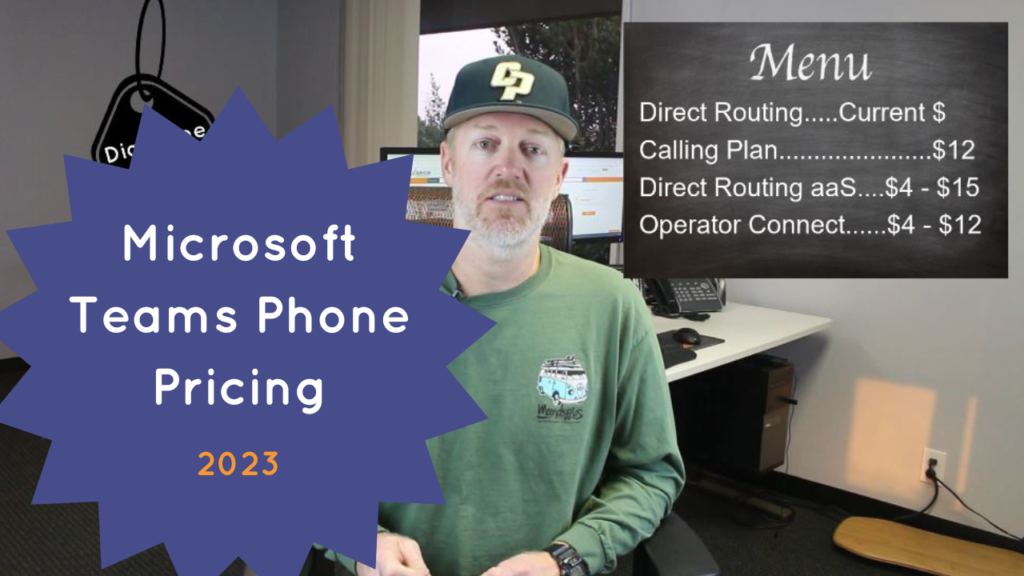What is the total price for Microsoft Teams Phone in 2023?
In the video below, Mike explains Teams Phone total cost, including licensing , dial tone options such as: Direct routing, calling plans, direct routing as a service, and Operator Connect.
Want Mike’s recommendations on the top 3 dial tone providers to quote, based on your company’s requirements? Click below and ask him today.
About Mike
Mike Smith has been helping companies select the best telecom, WAN, security, and cloud services since 1999. He founded AeroCom in 2003, and has been the recipient of numerous business telecommunications industry awards, including being recognized as one of the top 40 business people in tech-heavy Orange County, CA. Follow Mike on YouTube, LinkedIn, Reddit and SpiceWorks.
Transcript
Your company is shopping for a new phone system and you’re looking into Microsoft Teams Phone system, and you’re wondering, how much does it cost? Well, it’s kind of changed every single year. So I wanted to make a new video on the cost of Microsoft Teams Phone system in 2023. And I’m going to cover, in this video, I’m going to cover both the licensing costs as well as the actual dial tone costs.
Ask me who to quote
So before I get started, however, just a quick plug. If you’d like my recommendations on the best dial tone service providers for Microsoft Teams Phone system. Yes, you definitely want a different dial tone provider than Microsoft, if you have a large company and you’re getting Microsoft Teams Phone system. So if you want to know my recommendations on which vendors your company should be quoting for dial tone, give me a call (714.593.0011), shoot me an email. I’m happy to help. There’s definitely a lot of options out there. You don’t want to waste your time browsing through them on the internet. Instead, it’s absolutely free to just reach out and contact me. I’ll help you out. More information on that at the end of the video. Also, don’t forget to hit the like and subscribe button down below. That’d be a big favor to me and I’d really appreciate it.
This pricing is for January 2023
Okay, so your company is looking into Microsoft Teams Phone system, and you want to know how much does it cost? Well, great question. And this pricing is covering what the pricing is in January 2023. So whenever you’re watching this video, that’s when it’s applying for. If you want to know, if you’re watching it at some vastly later date, just reach out and contact me and I’ll help update you on that.
Licensing – E5 is the only difference-maker
But okay, so the first thing I want to talk about is licensing pricing. So the only licensing thing you need to think about when it comes to your business is do you have E5? Does your company have an Office 365 or a Microsoft 365 E5 license? That’s the only 365 license that makes a difference. And the reason why is that’s the only license that includes Microsoft Teams Phone Standard, which is that’s the add-on feature that you’re going to need in order to have, or in order to use Microsoft Teams Phone system. So Teams Phone Standard is only included with 365 E5. So it doesn’t matter. All the other licenses are the same except for that one. That one includes E5. So no matter whether you have E3, E1, Business Premium, Business Standard, all of those are going to be in the same category, which is if you have those other licenses, you’re going to have to get Teams Phones Standard as an add-on, which costs money.
So E5 is the only one that it’s included with. It’s a little bit more expensive than all the others, and it includes a bunch of other security features, things like that. So it’s a good excuse. If you want to move to E5, you’ve been wanting to move to E5 for a long time, this might be a good excuse time to move to E5 if you want Teams Phone system.
Adding-on Teams Phone Standard
But otherwise, if your company has any of those other licenses other than E5, you’re going to have to pay for a licensing add-on, which is called Teams Phone Standard. Now, you can either get that add-on as just a standalone, which is Teams Phone Standard without a calling plan, and that’s around $8 per month per user for that add-on. Or you can get Teams Phone Standard bundle with a calling plan, and that’s around $15 per month per user. So that includes Teams Phone Standard and the calling plan, which is the dial tone, which I’ll address in a minute.
When should you get the bundle?
So there’s a couple different options there. And the difference is if you are a larger company, meaning you have more than 50 employees, but more like 100 employees or more, you’re definitely going to want to get the Teams Phone Standard as a standalone product. That’s Teams Phone Standard without a calling plan. You don’t want to get the actual Teams Phone Standard bundle with a calling plan because you want to get your calling plan from someone else. If you’re a small company, you don’t really have an option to get a calling plan from someone else. So all these third parties that can do dial tone for your business, they really only cater to larger companies. So if you’re a smaller company, the best option is to get the Teams Phone Standard bundle. That’s $15 per month per user and includes the calling plan. But if you’re a larger company, get it as a standalone and get the dial tone from a third party, which I will talk about in a minute.
Splitting Your CSP
Now, something new that happened over last year is that for the licensing, you could actually split the licensing between, maybe you have a CSP that you’re currently using today that you really like for all of your Office 365 licensing or your Microsoft 365 licensing. And then for the actual Teams Phone Standard feature, Microsoft now is letting you split the licensing between two different CSPs for that feature specifically. So you can get all of your Office 365 licensing from your current CSP, but if you want to add the Teams Phone Standard, you could actually get that one from a different CSP. Now, why that is significant is because maybe that different CSP is your dial tone provider for Microsoft Teams Phone system.
And why that is significant is because now you have the support for your dial tone and your phone system software all with the same entity. So you’re not having to split that support between your CSP and your dial tone provider. So I hope that makes sense, but that’s something new that came out with licensing pricing last year.
Dial Tone
Okay, so now let’s talk about dial tone. So once you have your licensing squared away, which means you’ve added the Teams Phone Standard feature, now that’s great. Now you have the features and capability you need within the software, meaning you have a dial pad on Teams and all that good stuff. That’s the capabilities you need on your software. But now you actually need to add the dial tone for every user, which is a separate price.
Direct Routing
So your first option is to use your existing dial tone that you have today. So for instance, if your company has a PRI for your dial tone, or you have analog phone lines for your dial tone there. You can actually use that on-premise dial tone for Microsoft Teams Phone system. And the way you do it is through a feature called direct routing through Microsoft. So you can use that. So that’s number one. So the downside to on-premises dial tone is that you are in charge of the dial tone, meaning that you have to manage the direct routing feature. You also have to add a session border controller on site and manage all the codecs for voice quality on site. And also all the reliability is based on your company’s on-premises dial tone. So if your PRI goes down or your analog phone lines go down, or if you lose power in the building and your phone lines go down, none of your company is going to have access to dial tone through Microsoft Teams Phone system.
So for that reason, most companies are choosing to go to the cloud for their dial tone, which is the way the whole marketplace is going. Let’s face it, cloud dial tone, cloud phone systems are really dominating the marketplace today. So most companies that come to me are not looking to do on-prem dial tone. They’re looking to get dial tone in the cloud one way or the other.
Calling Plans
So the first way you can get dial tone in the cloud is through Microsoft’s calling plans that they offer. I mentioned this earlier. So Microsoft does offer calling plans, and it’s usually around $12 per month per user, and that includes essentially unlimited calling for every single user. And that’s great if you have a small company and you don’t really have an option of getting a third party for the dial tone, you can just go directly to Microsoft. You can get that bundle that I talked about earlier that includes both the Teams Phone Standard feature and a cloud calling plan for every single user for $15 a month total, so that’s kind of a good deal.
So if you think about it, $8 per user plus $12 a user is 20. So if you get both à la carte, it’d be 20. So they’re giving you a bundle for $15 per user per month, and that’s kind of a good little package there for small companies. So most companies, however, don’t want to get their dial tone from Microsoft directly. And the reason why is because especially if you’re a larger company and you have other options, you don’t want to have to go to Microsoft directly for your support. I mean, let’s think about it. Microsoft isn’t really known for having very high touch, very white-glove support. Everything for them is really pushed towards self-service support. And for a company’s phone system, especially a larger company, that’s just not the way things have ever been done. Usually companies need a little bit more hands-on support, so they don’t really feel comfortable going to Microsoft directly.
Direct Routing as a Service
So instead they want to go to a third party for dial tone. And that’s the third way of getting dial tone. So that way is called direct routing as a service.
So if you think about, remember the first option I talked about where you have on-prem dial tone with direct routing? Well, what this is, direct routing as a service is a third-party VoIP company that actually uses their on-prem dial tone. So a VoIP company has all types of redundancy built into their dial tone. They have the SBCs on site that they’re managing, they’re doing dial tone, they’re doing it really well. They’ve been doing dial tone for years and years and years, decades. And they’re saying, “Hey, we’ll do the dial tone for you and connect our dial tone to your Microsoft tenant through direct routing.”
So that’s why it’s called direct routing as a service. Your company is getting the dial tone through the cloud through the internet. They’re sending you the dial tone through the internet, but they’re using direct routing on their side to connect their dial tone to your company’s Microsoft tenant. So that’s why it’s called direct routing as a service. And that’s really exploded, especially since the pandemic. A lot of companies are offering that. And the benefit is, number one, it’s really only available to larger companies. So if your company has 50 to 100 employees or more, that’s when direct routing as a service is really an option. Anything smaller than that, it’s really not an option for you.

What’s the benefit for larger companies?
But for those larger companies, that’s a great option, for number one, because you don’t have to get the support directly through Microsoft. You’re getting it through a VoIP company that’s offering you free unlimited 24/7 support live. So you get a live person to talk to if your phone lines ever go down, things like that, you’ve got a live body to talk to just like you’re used to. So they offer that, where Microsoft does not offer that with their calling plan. You’re not going to get live 24/7 unlimited support live person on the phone with Microsoft if you get a calling plan with them, but with these third parties you can. So that’s number one.
Number two, they’re going to help you with the installation, with the porting of the phone numbers, all that good stuff. So you’re not going to have to tackle that all by yourself. They’re going to assign you a project manager and walk you through the whole process of installing Microsoft Teams Phone system. So big advantage there.
And number three, it’s going to be the same cost, or a lot of times even less than going directly to Microsoft for the dial tone. So they charge a little bit less, or at the very least the same, but you’re getting a lot more.
What about features?
And number four, a lot of times you can get more features and functionality from your dial tone when you use these third parties for direct routing as a service. So if you’ve seen some of my other videos, it’s no secret that Microsoft Teams Phone system has some feature gaps. You can’t do things like call center through Microsoft Teams Phone system. There’s little feature gaps here and there. Right now Microsoft still does not have SMS texting, so there’s a lot of different little features here and there. On demand call recording, advanced call reporting, things like that are missing with Microsoft Teams Phone system. But when you use a third party direct routing as a service provider, because they’re powering that dial tone with their own cloud PBX application, a lot of times they can add those missing features to Microsoft Teams Phone systems, so kind of nice.
So that that’s another option there.
Operator Connect
So lastly, the last option I want to talk about is called Operator Connect. So Operator Connect is kind of the next generation of direct routing as a service. It’s a third party service provider giving you dial tone for Teams Phone system, again, targeted for larger companies. And again, you get all the support through them, which is nice, and they help you out with the installation. But this one is more of a pure Teams Phone system offering. It doesn’t bring the extra added features. It’s more of a very clean, pure Teams Phone system instance. So you’re not going to get the added features, but you’re going to get a little bit more of a clean feel when it comes to getting Teams Phone system.
Their big claim to fame, Operator Connect, is that you can manage all of the phone numbers within the Microsoft Admin Portal as opposed to direct routing as a service providers, you have to manage those phone numbers within that third-party provider’s portal. So a little bit cleaner of an experience when you go Operator Connect, but there’s a limited amount of Operator Connect providers out there. So not all service providers can do it. So it’s a small group of providers that can do it, and that’s Operator Connect. So that’s all. And by the way, Operator Connect, again, like direct routing as a service, pricing wise, it’s definitely more geared for mid to large size companies. It’s around the same price or less than direct routing as a service, especially if you’re a large company. Some providers offer it for five, $6 per month per user, which is a lot less than Microsoft Direct, which is more around $12 per user. Remember that one?
So, which vendors are the best at this dial tone thing?
So something to think about there. And yeah, so those are all the different pricing options for Microsoft Teams Phone system in 2023. If you have any questions, reach out and contact me. But again, if you want my recommendations on which third party you should quote for either Operator Connect or direct routing as a service, don’t search it. There’s probably hundreds, if not thousands of options out there. Chances are you’re going to end up with the wrong one. Instead, just reach out and contact me, by email or by phone (714.593.0011). That’s my job. I’m a broker for all these major service providers. I’ve been doing it for over 20 years. I know the industry inside and out, and I’ll ask you a few questions. And based on your answer to those questions, I’ll pair you up with the best service provider for your company specifically.
And I’ll also introduce you to the best reps at those companies and oversee the quoting process, make sure you get the lowest pricing from the companies, all that stuff. And the nice thing is, on top of all that, you don’t have to pay me a dime for my service. The service providers pay me my broker fee. So there’s absolutely no excuse not to at least reach out and ask me my opinion on this stuff. Well, again, I hope this was super useful. If it was, don’t forget to hit the like button and subscribe to the channel. I’d really appreciate it, and I will catch you on the next video.







